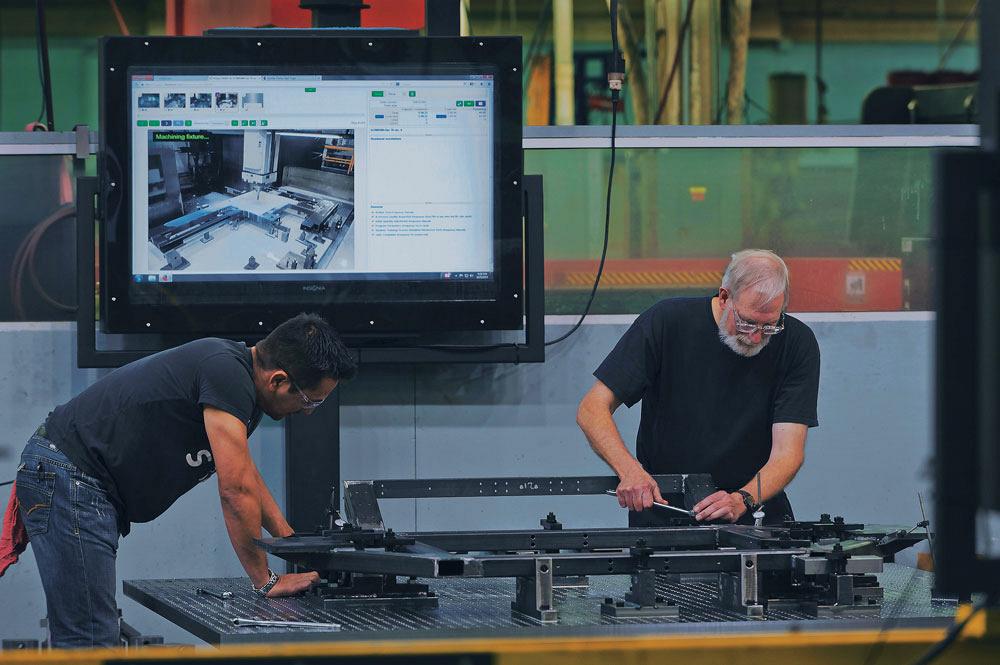head of technical documentation
- FMA
- The Fabricator
- FABTECH
- Canadian Metalworking
Digitally optimizing manufaturing work instructions
Transitioning to digital work instructions is about much more than simply going paperless
- By Sylvie Couture
- Updated May 18, 2023
- April 22, 2020
- Article
- Automation and Software

The right digital work instruction application can give manufacturers the tools to do everything from create intuitive multimedia instruction to track production trends.
Gone are the days of missing pages, coffee-smudged instructions, and that one rogue outdated assembly process that keeps turning up every so often. Welcome to the age of digital work instructions. In addition to saving trees and reducing papercuts, they can be an invaluable asset when it comes to streamlining and optimizing every step of your manufacturing process.
8 Areas That Benefit From Digital Manufacturing Work Instructions
The right digital work instruction application can give you the tools to do everything from create intuitive multimedia instruction to track production trends. This next section explains some of the benefits that you can expect from digital work instructions. Of course, not every application offers these options, so it is important to know what is out there and what you need before you invest your time and money into one.
1. Work Instructions
Now that you have stepped away from the restrictions of printed work instructions, an entire world of options is open to you. You now have everything you need to create in-depth, thorough, and stimulating work instructions that will guide you in a way paper instructions never could.
How to do it:
- Use mixed media. Using a variety of media such as videos, images, audio recordings, and text can help you create richer and more intuitive instructions.
- Use instruction versioning. This basic yet essential feature ensures that only the latest version of the work instructions is made available to your workforce, while past versions are archived and available for reference. This avoids confusion and gives you the peace of mind that your team is on the same page.
- Collect information from your workforce during the production cycle. Look for an application that allows you to place forms within your work instructions to gather data and feedback from your operators. It is also important that this information be easily accessible in reports and ideally be exportable as well.
2. Training
The material delivered in verbal training sessions can vary greatly depending on the trainer’s work methodology. By using these work instructions as a complement to verbal training, or as a substitute altogether, you are able to capture your organization’s best practices and create processes that will be respected throughout the company.
How to do it:
- Use a mix of multimedia items that can be combined in the work instructions to appeal to the different learning needs of a variety of individuals.
- Add additional material in the training work instructions that the operator can consult if needed. Examples are links to more explicit tutorials or the PDF of a tool’s complete user guide.
Some applications also allow you to track a user’s training and certifications. This can be a valuable feature when supervisors are organizing or planning their workforce activities.
3. Production
Now that you no longer have to worry about operators using incomplete or obsolete documents, your work instructions can be turned into production-enhancing tools. With all the options available, you can create clear, in-depth, and intuitive instructions that also gather production information.
How to do it:
- Include information on machinery setup and adjustments. This will save time when a new operator starts work on the machine.
- Include forms in your work instructions that capture production information from your workforce. This will let you monitor production and detect issues early on.
- Add additional information in attachments for operators who are still getting up to speed. Some applications actually give you the ability to distinguish between steps for beginners and steps for experts. This is ideal since it lets your new staff learn, without slowing down your more experienced operators.
If you are ready to go all out in fine Industry 4.0 fashion, applications that are IoT-compatible can be linked to smart tools and actually control the progress of the work instructions as well as record the tools’ values.

Now that you no longer have to worry about operators using incomplete or--obsolete documents, your work instructions can be turned into production-enhancing tools.
4. Quality
Reduce quality inspection time by integrating it into your work instructions. Use the multimedia options to help operators achieve the quality you are expecting. Work instructions also can be created just for quality inspection purposes.
How to do it:
- Add check lists to work instructions so they are recorded within the reports and are not misplaced or forgotten.
- Request that operators take and upload images during the assembly process as proof of a job well done.
- Use images to depict acceptable and unacceptable results. Visual cues are powerful.
- Request a confirmation signature from a quality expert before the work instructions can be closed. Although this is a more advanced feature, it can greatly improve your company’s accountability.
5. Traceability
Traceability is a growing requirement in the manufacturing domain. You never know when a part recall or new compliance rule will pop up. Keep track of the elements in your assembly or process by selecting an application that allows you to record critical information.
How to do it:
- Use production reports as a record of all the information recorded during the use of the work instructions. This should include all quality inspections as well as pictures taken throughout the process.
- Record the elements that are used in your assembly. Look for an application that will let you use bar code readers because this will make entering the part numbers faster and will reduce the chance of errors related to manual data entry.
The main advantage to choosing an application with advanced traceability options is that all your production information is centralized in one location and therefore easy to access and export if you ever need it.
6. Service and Maintenance
Work instructions are in no way limited to production. Just like normal work instructions, service and maintenance procedures are ideal candidates for digitization. Use your newfound technology to centralize the results of your service and maintenance findings, and never wonder if anything was forgotten again.
How to do it:
- Fill the maintenance guide with reference images showing the areas that must be inspected and what the desired results are. Combining the images with text reaches out to those who relate more to visual cues.
- Integrate forms and check lists. Once again, select an application that will let you enter important data into the work instructions. Don’t run the risk of having important information be lost or misplaced.
- Use the full power of user feedback to guide your technicians. More advanced applications can bring the user to specific places in the work instructions depending on the information they enter. For example, if it is determined that an item requires maintenance, the user will be redirected to the work instruction step that explains the proper procedure to follow.
7. Operations
In addition to centralizing your information, some digital work instruction applications also allow you to track your production information in real time, as well as analyze production trends.
How to do it:
- Use production reports. Production reports should be the centralized location where all the production information generated by the work instructions is stored. This is also where you will be able to store the information on what parts are in your assembly.
- Add key performance indicators (KPIs). Applications with KPI monitoring should allow you to track specific vital information throughout the production process, such as the number of items produced by a production line.
- Configure statistical process control (SPC) charts. Use these handy charts to see how your process evolves over time.
There is enormous power in your data, and being able to access all your vital production information in one place gives you a huge advantage.

In addition to centralizing your information, some digital work instruction applications will also allow you to track your production information in real time, as well as allow you to analyze production trends.
8. Auditing and Health and Safety
Once you have mastered your work instructions, why not move on and discover other areas that can benefit from your new application? Use your application for any task that requires a specific process to be followed with data that needs to be recorded.
How to do it:
- For auditing purposes, much like the maintenance guides, create detailed work instructions that allow the auditor to enter their findings directly into the application. This will help you consolidate and gather all the audit information you need.
- Health and safety also can be integrated into work instructions through the use of pictograms indicating the protective gear operators require during a process. Links or attachments to first aid documents also can be appended to the instructions. Of course, you also can use digital work instructions independently for health and safety audits and verifications.
Choosing the Right Digital Manufacturing Work Applications
Once you have decided to make the transition to digital work instructions, it is time to start shopping for the application you want to use. Although the number of applications to choose from might seem overwhelming, here are some important things to keep in mind that will help you narrow down your search and choose the application that is right for you.
Features. Most applications offer more than just a way to put your work instructions online. Be sure to review the feature list and find the one that meets your needs.
Trial Periods. Trial periods are important because they let you get a feel for the software and try the program on your own. Make sure that support is offered during the trial period.
Pricing. Find an application with a pricing system that meets your needs. Is the pricing scalable per number of users? Is it a one-time fee, a monthly fee, or a yearly fee? Are updates to the application included in the price?
Required Material. Digital work instructions, as the name implies, require your operators to view the instructions using an electronic device. Inquire what devices and platforms the application is compatible with and if there is an ideal screen size or resolution recommended for the devices.
Security. Your work instructions contain important confidential information. Don’t be afraid to inquire about how the application provider keeps your information safe and confidential.
Support. Make sure the application offers customer support that will help you get the most out of your new work instructions. Here are some useful questions for the vendors: Is there a help website? Are there tutorials or webinars? Is support staff available, and what is their reply policy?
Once you find the right application and become comfortable with it, you will rapidly appreciate the positive changes digital work instructions bring to your organization.
Sylvie Couture is the head of technical documentation at VKS, 1241 Cascades St., Chateauguay, Que. J6J 4Z2, 855-201-4656, www.vksapp.com.
About the Author
Related Companies
subscribe now


Keep up to date with the latest news, events, and technology for all things metal from our pair of monthly magazines written specifically for Canadian manufacturers!
Start Your Free Subscription- Industry Events
Automate 2024
- May 6 - 9, 2024
- Chicago, IL
ANCA Open House
- May 7 - 8, 2024
- Wixom, MI
17th annual Joint Open House
- May 8 - 9, 2024
- Oakville and Mississauga, ON Canada
MME Saskatoon
- May 28, 2024
- Saskatoon, SK Canada
CME's Health & Safety Symposium for Manufacturers
- May 29, 2024
- Mississauga, ON Canada




















